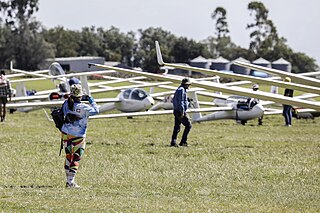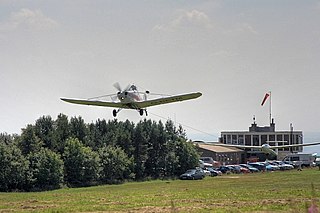
In most countries one is required to obtain a glider pilot license (GPL) or certificate before acting as pilot of a glider. The requirements vary from country to country.

A private pilot licence (PPL) or private pilot certificate is a type of pilot licence that allows the holder to act as pilot in command of an aircraft privately. The basic licence requirements are determined by the International Civil Aviation Organization (ICAO), but implementation varies from country to country. According to ICAO, an applicant must be at least 17 years old, demonstrate appropriate knowledge and skill, and hold at least a Class 3 medical certificate. Different PPLs are available for different categories of aircraft, such as aeroplane, helicopter, airship, etc., and are not interchangeable, although experience from a PPL in one category may be credited towards the issue of another.
Pilot licensing in the United Kingdom is regulated by the Civil Aviation Authority (CAA).

The London Gliding Club (LGC) is a members' club whose airfield is located at the foot of the Dunstable Downs. Many privately owned gliders are based there. It has the facilities to train pilots in powerless flight, and in the skills necessary to fly cross country using nature's sources of energy. Aerobatics and instructor training are also available. The LGC is open 364 days a year and is the second largest and one of the oldest Gliding Clubs in the United Kingdom, smaller only than Lasham Gliding Society. The club provides gliding courses, one day courses and trial lessons for members of the public.

Windrushers Gliding Club was a gliding club flying from Bicester Airfield in Oxfordshire until late June 2020. At its heyday, the club was one of the biggest gliding clubs in the UK, hosting various competitions throughout the year and maintaining the physical presence of the British Gliding Association's shop as well as numerous BGA staff members. The club operated seven days a week, with paid staff running various elements of the club's operations.

Gliding Federation of Australia, also known as Gliding Australia, is the governing body for the sport of gliding in Australia. It was founded in 1949. Gliding Australia is responsible to Civil Aviation Safety Authority for the conduct of safe gliding operations in Australia. This includes the setting and maintenance of flying standards and in particular training standards, for gliding and soaring flight in heavier-than-air fixed-wing gliders and sailplanes, powered sailplanes and touring motor gliders, but excluding flexible wing, weight shift hang gliders and paragliders.

The Soaring Society of South Africa (SSSA) is the body to which all gliding and touring motor gliders in South Africa must belong, as stipulated in law by the South African Civil Aviation Authority (CAA), to pursue the sport of gliding within South Africa. It is affiliated to the Aeroclub of South Africa which also represents all the sporting bodies at the CAA. Membership is by subscription directly to the SSSA.

Philip Aubrey Wills CBE was a pioneering British glider pilot. He broke several UK gliding records from the 1930s to the 1950s and was involved in UK gliding administration including being Chairman of the British Gliding Association (BGA).

General aviation (GA) in the United Kingdom encompasses a variety of commercial and non-commercial aviation activities.
The British Aircraft Company was a British aircraft manufacturer based in Maidstone. It was founded by C H Lowe-Wylde and produced gliders and light aircraft during the 1930s.

Gliding is a recreational activity and competitive air sport in which pilots fly unpowered aircraft known as gliders or sailplanes using naturally occurring currents of rising air in the atmosphere to remain airborne. The word soaring is also used for the sport.
The Sproule-Ivanoff Camel was a 1930s British single-seat medium performance glider designed by J.S Sproule and Alexander Ivanoff and built by Scott Light Aircraft of Dunstable, Bedfordshire.
The Moore Gypsy or Birmingham Guild BG 100/12 and BG 135 is an early all-metal single-seat glider designed in the UK in the late 1960s. Several longer span variants were produced by various manufacturers. The first BG 135 was still flying in 2011.
The Penrose Pegasus was a 1930s high-wing, single-seat, wooden glider from the UK. Designed, built and flown by Harald Penrose until the start of World War II, only one was built at the time though a reproduction was constructed in the 1990s.
The Radlock Trainer was a single seat primary glider designed and built by members of the Hull Experimental Gliding Club as a basic trainer for their own use in the early 1930s. It was a simple, single exposed seat, wooden glider with a parasol wing.
The Reynard R.4 Primary was an open seat primary glider with an open girder fuselage and a high, wire braced wing. It was designed and built in the UK in 1930 and a few served Gliding Clubs in England and Ireland.
The Stedman TS-1 City of Leeds was a parasol wing wooden sailplane, seating two in tandem open cockpits. Only one was built, by its designer in 1934; it remained active until the outbreak of World War II.
Zbraslavice Airport is located 1,5 km North of the small city of Zbraslavice, near the main motorway nr. 126. between the city of Zbraslavice and Štipoklasy village in Central Bohemia. The airfield may be used by light aircraft, helicopters, gliders and ultralights. The keeper is civic society Aeroclub Zbraslavice. Zbraslavice airport is the synonym for superior gliding conditions among pilots and fans of aviation sports worldwide. Therefore, the airport is a place where a number of national and international competitions is held and a lot of pilots from the Czech Republic use the airfield as training base.

The Yorkshire Gliding Club (YGC) operate from an airfield on Sutton Bank in the North York Moors National Park, England. The airfield site is 7 miles (11 km) east of Thirsk along the A170 road and just south of the National Park visitors centre at Sutton Bank. The club formed in 1934 from an amalgamation of gliding concerns from the West Riding of Yorkshire and has been in existence for over 80 years and has had many famous fliers such as Nicholas Goodhart, Amy Johnson and Fred Slingsby.
This is a glossary of acronyms, initialisms and terms used for gliding and soaring. This is a specialized subset of broader aviation, aerospace, and aeronautical terminology. Additional definitions can be found in the FAA Glider Flying Handbook.










